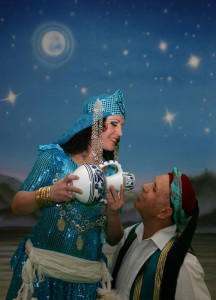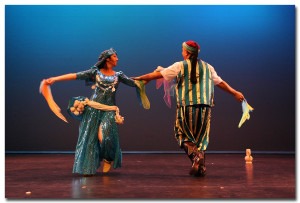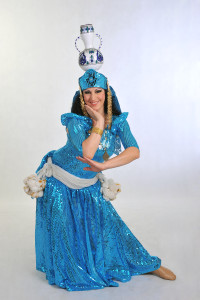

 Raks Fezzani is one of main traditional Tunisian folkloric dances. It is also referred to as Raks Sharbia (Pot/Jar Dance). Fezzani style is originally from Fezan, Libya and you can see the strong connection between Fezzani and the Hagalla as they share some of the same strong hip twists. In Fezzani however, these strong hip twists are executed while sometimes balancing a Sharbia (Jar) on the head.
Raks Fezzani is one of main traditional Tunisian folkloric dances. It is also referred to as Raks Sharbia (Pot/Jar Dance). Fezzani style is originally from Fezan, Libya and you can see the strong connection between Fezzani and the Hagalla as they share some of the same strong hip twists. In Fezzani however, these strong hip twists are executed while sometimes balancing a Sharbia (Jar) on the head.
Some of the typical Tunisian rhythms used are Fezzani Tounsi & Arroubi 4/4, Fezzani Tribilzi 12/8, Al Allegi 6/4, Al Ghita 6/8, Djerbi & Kerkenah (4/4) (Folklore from the Islands), Bounawara Tounsi & Agrabi 4/4, Saadaoui 12/8, El Halla 6/8, Souga & Souga Sellami 12/8 and many others.
The traditional Tunisian costume has many components. The Melia itself can be anywhere from 4 to 5 meters of fabric. The Melia (translated means to make full) is similar to the Melaya from Melaya Lef (Lef meaning to throw) from Alexandria, Egypt, both used as a cover to show modesty. Pantaloons or Serwel are worn underneath as well as a shirt or Khamees. The head is covered with a scarf and a decorative headband of colorful fabric. The headband  can be decorated with a headpiece called Jbeen or Gossa. Jewelry hanging on the sides of the Gossa by the ears are called Swelif or Nawathar.
can be decorated with a headpiece called Jbeen or Gossa. Jewelry hanging on the sides of the Gossa by the ears are called Swelif or Nawathar.
The Melia is held together at the top with two pins called Kholail that can sometimes have looped chains extending from one pin to the other. The ensemble is called Hijr and the chain by itself is called Reyhana. Other traditional jewelry that can be worn are:
 Hand of Fatima decorations
Hand of Fatima decorations
Bracelet – N’bila
Belt Ring – Hilga (meaning circle)
Ankle Bracelets – KholKhal
Earrings – Illaget
Belt – Hizzam
There are many steps and combinations in Tunisian Fezzani and each one can be used with a variety of the aforementioned rhythms but altered to stay in the frame of the musical rhythm. Most steps are executed on the balls of the feet.
References: Mustapha El Oueslati, [email protected], Khiera Oubeidallah, Former Principal Dancer and Professor of the Tunisian National Folklore Ensemble. Khadejah El Oueslati, [email protected], Professor Hichem Khediri, [email protected]